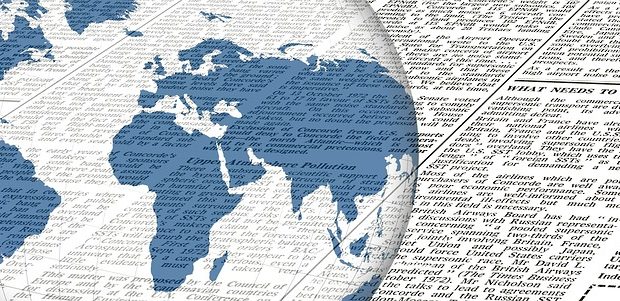(excerpt from the publication One Day in 2053, published in 2013 by Anticipolis)
The crisis we are going through is not just a short-term economic crisis. This is a crisis that we have identified as historical since the beginning. In February 2006, we characterized it as challenging “the world as it had been conceived at the end of the Second World War”. But soon, we realized that it was in fact questioning the European world that was invented during the Renaissance with the great discoveries more than 500 years ago.
In fact, we are emerging from a 5 “European” century era (including in its American or Soviet avatars) into a multipolar world. This process has been ongoing for some twenty years, but we are currently in the final stages of this multi-polarization, with its cohort of difficulties – linked in particular to the integration of this new reality into the institutions of global governance.
This multi-polarization of the world calls into question the whole system that we Europeans have invented over the past centuries and decades. The new world has yet to be organized as harmoniously as possible and 2053 will depend on the success of this reorganization. And just because the world will no longer be singularly European does not mean that we Europeans will not have to continue to contribute to it; Europe even has a particular responsibility in participating to the invention of the future world, if it wants to remain a major player.
Towards which global governance are we heading?
With regard to the functioning of the current institutions of global governance (“UN” system in the broad sense), we have quite recently come to the conclusion that there is no possible reform and ultimately no desirable reform because the entire UN system is dated, totally rooted in a 20th century world and structurally incapable of integrating the complexity of the emerging multipolar world.
For example, even if we succeed – which is very unlikely[1] – in changing the composition of the UN Security Council by adding Brazil, Mercosur, the African Union or South Africa (Editor’s note: to be placed in the context of 2013), does not mean that we have really put the UN back in the position of keeping the world in order.
This conclusion leads us to another one: we must therefore completely reinvent global governance adapted to the completely new characteristics of the post-crisis global systemic world.
We believe that the models that already exist today and on which the world of tomorrow must / will be built are:
. on the one hand, the European model: LEAP affirms what is obvious to the rest of the planet but that Europeans themselves have a problem understanding, namely that the European integration process conducted over the past 60 years is a real reference, relevant not only for other regional integration experiences (African Union, MERCOSUR, ASEAN, etc…) but in the invention of tomorrow’s global governance.
. on the other hand, the BRICS model: it is indeed an innovative experience consisting of a club of countries sharing objectives and deciding to join forces, at least occasionally, to join forces for common purposes; in this case, this common purpose constituting the primary driving force behind the BRICS association is precisely the reform of global governance in favour of the integration of emerging countries into international decision-making mechanisms.
These two models of political organization (“political” because they increase the “power to do”) make it possible to imagine the next system of global governance as a network of diverse and varied components: nations, integrated regional entities (e. g. the African Union), integrated regional sub-entities (e. g. ECOWAS), trans-national “clubs” of interest (BRICS type). Unlike the de facto pyramid system that characterizes the UN model of global governance, a networked system will integrate the structural complexity of tomorrow’s world.
This global network composed of the various building blocks of the global organization will be led by coordination mechanisms (e. g. Global Coordination Secretariat – GCS – on issues related to nuclear waste management,etc…), light structures (composed of a small number of employees compared to the current overwhelming system), flexible/agile structures (likely to be shut, especially if they are linked to the implementation of a specific project; e. g: GCS of anti-personnel mine clearance), thematic (food, trade, nuclear… security) and variable geometry (grouping entities wishing to join the project in question).
There will of course be Secretariats more central than others (super-secretariats), ensuring the proper functioning of the entire system, but it will essentially be a decentralized, de facto polycentric system.
This system will incorporate modern communication methods (Internet, airplane, and everything that will exist in 2053 in this field) and will avoid large groups of employees gathered in localized Babel towers (New York, Geneva…). Conversely, the people employed in this network will work remotely, and may even participate in a GCS as employees of a specific national or regional entity.
We imagine a gradual and empirical implementation of this type of governance over the period 2015-2025. Of course, this mode of organization will still be in place in 2053.
The Global: Towards a basket of currencies as an international reserve currency
As part of our work on the crisis, we have also addressed the issue of the international monetary system, the current one being considered largely responsible for the global problems we are facing. Since 2009, we have identified as a key to ending the crisis the creation of a new international reference currency based on a basket of currencies of the powers representing the world economy (US Dollar, Euro, Yuan, Rouble, Real,…), which could be called “Global”, the first multipolar currency, based on the reality of global economy and as such legitimate to serve as its currency of exchange. Such an evolution is desirable from now on. Large players (China, BRICS,…) have been working to move in this direction. Unfortunately, for the time being, we are seeing that other players essential to the decisions needed to start the process are blocking everything. There is therefore a return to regional currencies for the time being, with the process of internationalization of the Yuan (a process that depends on no one other than China) to be seen as a useful step towards the creation of a basket of currencies.
In any case, by 2053, it is certain that we will have moved on to something other than the US dollar and this other thing, we anticipate that it will look very much like a kind of global Euro.
Globalisation, protectionism, at what stage of the cycle shall we be in 2053?
Over a shorter period (2015-20), we anticipate a certain de-globalization in favour of an intensification of intra-regional trade (ASEAN, Mercosur, EU, AU…). Overall, trade flows will probably increase, but their distribution will continue to restructure geographically. Distrust of free trade agreements between major regions will be the rule over the next decade. But by 2053, a renewed world governance, having learned the lessons of the excesses of 20th century globalisation, will restore sufficient confidence to allow a “reasoned” reopening of trade by 2053.
Democratization processes in the world by 2053
At first glance, we can imagine a world in 2053 whose increasing complexity, population densities and the prevalence of new political models from Asia will probably lead to a hardening of political systems. This hardening is already underway: in the 1970s, Western society was much freer than it is now. Things are certainly not going to get any better.
But this point of view (on a democratic retreat) is in fact a Western point of view. There is in fact every reason to be quite optimistic if we calculate democracy on a global scale. Since the fall of the Iron Curtain, democracy has already made great strides in the world (Russia, Central and Eastern Europe). In India, South America and even Africa, there has been real progress, not to say in some cases the emergence of new models of democracy. The remaining areas of shadows (North Korea, Saudi Arabia, China) are destined to open up.
China, the central actor of tomorrow’s world, seems particularly reluctant on this issue. But a China that is developing its internal market, seeing a middle class emerge, and therefore an aspiration for happiness and freedom, knows that the connection of its political system with its citizens is obviously on the agenda in the coming decades. But when you have behind you a 5000 years old civilization, you know how to use time.
On the more institutional aspect, by 2053, the top of the democratic edifice will have moved from the national to the supranational level. Representatives of the peoples of Europe, South America, Africa, Asia… will be elected directly by universal suffrage or something equivalent. We will therefore have a supranational democracy articulated with the national, regional and local levels of democracy. The debate in 2053 will probably be on how to democratize the global level.
Incidentally, it is up to us Europeans to initiate this democratisation of supra-national entities. This would be the logical conclusion to having initiated this regional integration process: achieving democratised regional integration models, including citizens’ involvement in decision-making mechanisms.
We can then imagine a world that will be led by a dozen or so VGLs (Very Great Leaders), who will meet regularly to make major decisions on the basis of real popular mandates. These VGLs will initially represent a mix of regional entities and large nations (United States, China…). That said, on our way to 2053, it is likely that we will have witnessed processes of geopolitical dislocation of large countries (organized or not) re-federated as supra-regional entities (e. g. the Reunion of Chinese Countries instead of China).
Finally, the Internet should make it possible to democratize sectoral decisions (by professions, cultural groups, etc…), which will certainly be combined with the democratic structure described above. We will thus obtain a “complexified” but operational democratic system composed of the traditional hierarchical levels (supranational, national, local…) and transversal mechanisms of citizen consultation, who will also have the possibility of electing their representatives by sector of activity and life.
What with the United States?
A word about the United States before moving on to Europe. This country has the most to lose in this global transition, namely its first place. But they have even more to lose in their resistance to change. First, we see how they are becoming economically exhausted in having to support the global economy to preserve the pre-eminent role of their currency. This effort, which literally crushes American society, creates enormous political tensions. The US structure is already being challenged at the moment, with states like Texas and others reflecting on the conditions that must be met to be able to secede. The dislocation tendencies of the union of the United States are therefore already present. They will be followed by a major political hardening (of the type of army takeover) in the second half of the 10’s, early 20’s maximum, with possibly a phenomenon of a quasi- “iron curtain” falling on the country. But this hardening will allow to block for a moment only the inevitable process of division-recomposition of the country. Thus, we hope that in 2053, the United States will be out of the black rut it has already entered.
What Europe in 2053?
In terms of governance, the European Commission and the entire EU framework that presided over the main orientations of the European project in the 1990s and 2000s, as in the case of the UN, will still be there but will no longer have much importance or influence. The new European executive framework will have been reconstituted on the basis of the Euro zone.
This development is already under way: isn’t the ECB and the Eurogroup taking the important decisions concerning the Euro zone – the group of European states bound by the highest degree of integration, for which it is therefore the most imperative to implement an effective framework for problem-solving and strategic guidance. The Euro has de facto created a new “Sovereign”, a Euroland, which already has an embryonic institutional architecture (a central bank, an executive mechanism,…) that has yet to be completed… and democratised.
Towards which Europe will this institutional system take us? By 2053, Euroland will have regained the size of the EU; the United Kingdom, which will have been a separate entity for some time (Editor’s note: to be placed in the context of 2013!!), will have returned to the fold (under continental conditions this time); in total, Euroland will probably even count more states than the current EU, not so much because it will have expanded geographically, but because some of its members will have divided following requests for regional independence (Catalonia, Scotland…. the former may even trigger a real wave).
Concerning the institutional geography of Europe, about ten years ago, LEAP launched the Euro-Rings project, which advocated a polycentralisation of the European institutions, that we felt should be taken out of their Brussels ghetto at all costs and distributed in the major symbolic European capitals (including Brussels, of course), with the aim of bringing them closer to European citizens and more generally to reality. This visionary project, which would inevitably have gone hand in hand with the in-depth reform of European governance that is so lacking in today’s Europe, has of course not found the political leaders to support it and has therefore remained a dead letter to date (worse, the European Parliament is struggling to refocus on Brussels).
However by 2053, and as part of the transfer from EU to Euroland governance, European institutional geography will be deployed over different power poles throughout Europe. Isn’t the ECB, the original institution of Euroland, in Frankfurt and not Brussels?
In democratic matters, there will be a political staff (individual or team) elected on the basis of single constituency elections in charge of Euroland (hopefully even as early as 2019 – Editor’s note: to be placed in the context of 2013).
What obstacles on the road to 2053?
Finally, let us consider the obstacles that may arise in the way of this scenario.
The geopolitical tensions inherent in the transformation of the current world can undeniably turn into conflicts, or even globalized conflict, by the end of the decade. There are also significant risks of democratic breakdown in the West, particularly in the United States but also in Europe.
The good news is that by 2053, these pitfalls related to the current crisis will be behind us anyway. However, we anticipate that with or without major disruptions (geopolitical or democratic), the future we are heading towards will look like the one presented above. The disruptions will only be attempts to slow down or accelerate the inevitable process of multipolarization of the world and its organization.
For sure 2053 will not be the same depending on whether we have gone there thanks to the good decisions taken by our leaders or through wars and major disasters, but on these aspects of multipolarity, governance characteristics, democratic functioning, etc… the world of 2053 will probably not be very far from what has just been presented.
In any case, it is good to keep in mind that 2053 will be what we do with it every day.
————
[1] It is Europe, once again, that holds the key to a recomposition of the Security Council, in particular by abandoning its two French and British seats in favour of a single European seat, which would open up the prospects for a Security Council composed of large regional entities of comparable size. But it is not now that the English are about to leave the EU that such a development is likely to happen (Editor’s note: to be placed in the 2013 context).


 LEAP2040 Toutes les informations et archives Europe2040
LEAP2040 Toutes les informations et archives Europe2040



